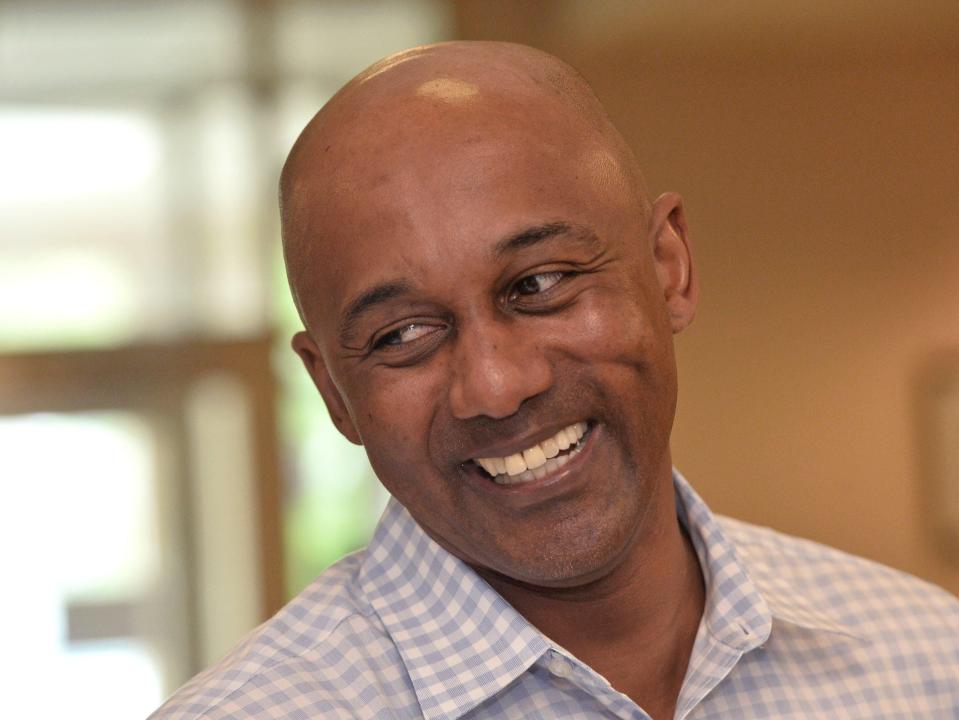Engage with Diverse Erie's efforts to dismantle Erie racism
Gary Lee said it more than once.
As the newly formed Erie County Diversity, Equity and Inclusion Commission worked through all the paperwork, policy decisions, legal and financial planning, hiring, outreach and brainstorming needed to stand up a brand-new government commission, he never lost sight of the promise underlying the churn.
“We are making history,” said Lee, the commission’s chief administrative officer.
The DEI Commission, now known as Diverse Erie, on Monday announced the first instrument of change to emerge from that labor — the Generational Impact Grant program.
Applications are now open for grants of $100,000 to $500,000. They require a one-to-one match, and must target capital projects that impact Erie County’s Black, Indigenous, and people of color in the county's poorest areas.
The grants mark the first tangible expression of the community's collective will, coalesced in 2021, to apply funding at scale to address Erie County’s most intractable, damaging racial disparities. And it comes at a time when so many plans aligned with that mission could benefit — an East Side Renaissance on Parade Street, Buffalo Road revitalization and new enterprise at Joyce A. Savocchio Business Park.
More:East Side Renaissance: Erie group eyes multimillion-dollar upgrades along Parade Street
More:Plan for Erie's Savocchio Park seeks “major investment”
“It is definitely a victory for all of us in Erie County because we've heard the negative press, that Erie is one of the worst places for Blacks to live. And so now we are a part of the transition changing that. I'm really excited to be part of the team," said Tiffany LaVette, vice chair of the Diverse Erie board.
More:Slavery’s legacy in Erie and the unfulfilled promise of Juneteenth
Racism a public health crisis
The COVID-19 pandemic and the disparate toll it took on the health and livelihoods of people of color put Erie County’s longstanding intolerable inequity in a harsh spotlight.
Erie County and the city of Erie in 2020 both declared racism a public health crisis. The county’s resolution forcefully ticked off the ugly data — health, hunger, poverty, wealth, unemployment — establishing the badly tilted fields on which lives are built here. Black people are disproportionately sicker and poorer than their white neighbors and have disparate access to the means through which citizens prosper and thrive — fresh food, business and home ownership, transportation, educational opportunity.
More:Diversity, Equity, Inclusion Commission launches first grant program; Davis gives support
“Anti-racist policy requires fundamental changes to all structural systems in Erie County, the dedication of resources and the development and implementation of effective strategies and programming,” read the county’s resolution.
County Council in 2021 put those "fundamental changes” in motion when it voted unanimously to create the Erie County Diversity, Equity and Inclusion Commission and seeded its efforts with $7 million in American Rescue Plan Act funds, money meant to relieve those communities most impacted by the pandemic.
More:How Erie County is addressing its other public health crisis: racism
But how exactly to repair complex, layered damage rooted the country’s original sin of slavery and white supremacy and still animated by human nature's basest instincts?
That legacy is not remote, but part of Erie’s warp and woof. Mercyhurst University historian Chris Magoc wrote in a Juneteenth column of prominent Erie residents who enslaved Black people. Research by Jonathan Burdick of the Erie Reader surfaced Ku Klux Klan activism in Erie in the 1920s — its members openly parading, politicking, preaching and committing acts of cross-burning terror in Erie.
Working in bondage to build someone else’s wealth hems in prospects. So does organized hate and being barred from one of the most fundamental tools to build wealth — home ownership. The federal government in the 1930s redlined minority neighborhoods here, deeming them unworthy of investment. Restrictive deed covenants fenced out those who would escape impoverished neighborhoods for the leafy suburbs.
The contours of our neighborhoods, institutions and uneven doorways to access are not naturally occurring, but enduring trace evidence of that not-so-distant past. And structural barriers aside, raw bigotry endures, erupting on social media feeds with the slightest of nudges.
It would be easy to get lost in anger, and despair.
Diverse Erie board maintains focus amid political change
Diverse Erie Board Chair Gerald Blanks, Lee and other members of the commission don’t have the time or interest for that. The new commission members in meetings I have attended in recent months keep disciplined focus forward on both start-up tasks and long-term strategies to resolve the dire conditions laid out in the county’s declaration. They are not looking at one-offs but investments in capacity-building strategies needed to bridge deficits, fuel agency and make generational change via housing, small business development and education and training — especially in skilled trades where people of color are underrepresented.
“l very strongly believe that these three items are really going to start to close the gap,” Blanks said.
The grant program announced Monday is just the first of more initiatives to come. The commission has been consulting with experts at the Center for Black Educator Development in Philadelphia for guidance on how to bolster local school districts’ efforts to recruit teachers, especially diverse teachers, something proven to improve educational outcomes for students of color. They also seek to partner with existing programs and charitable and philanthropic resources to leverage their own funds for the greatest impact and to avoid duplication of effort and waste.
The panel organized and took swift action while under tremendous political pressure that emerged almost at its creation. County Executive Brenton Davis came into office advocating for Erie County Council to reallocate $26 million in ARPA funding in the service of long-term economic development, which could result in the reallocation of the second $3.5 million Diverse Erie installment set to arrive in 2022.
Davis expressed support for the commission’s new grant program on Monday. How the next round of county ARPA funding will be distributed remains an open question, though. The answer hinges on whether County Council adjusts the funding plans that council devised in 2021 with public input and study.
DEI a community priority - for good reason, including growth
Backlash reliably accompanies advances in Black Americans’ and other marginalized communities’ access to our foundational liberties.
But in Erie at this moment, that sickness largely remains at bay, at least in places that matter most. And that is an aspect of our character and history to celebrate and nurture. While there were enslavers among the founders, high-profile local abolitionists recognized the evil of that economy and resisted it, as did residents later fight Klan hate.
Diverse Erie’s Monday announcement came soon after leading representatives from government, business, and nonprofit and philanthropic organizations unveiled a wide-ranging investment playbook, Erie Inclusive Growth: A Framework for Action. Drafted with the help of urban policy expert Bruce Katz, it positions the Erie region to seize its share of the expected trillions in federal investments set to flow in the coming years. With its explicit aim to bolster inclusion while improving pivotal aspects of life here — industry, housing, infrastructure, the bayfront, neighborhoods and more — it should prove a powerful companion to Diverse Erie’s efforts.

Acting and investing with intention to ensure everyone feels welcome and included, with shared access to opportunity, is a matter of justice, but also deeply practical.
As Celina Barrios-Millner and Christina Stacy of the Urban Institute note in their column, “there is overwhelming evidence that spurring economic growth and closing racial gaps are intertwined.”
Erie can’t attract young people and new businesses and grow in this rapidly diversifying country if it surrenders to gross racial inequities that stymie our greatest resource — human potential. As DEI expert Trent Hargrove writes in a column, DEI efforts are so crucial to development, Fortune 500 companies like Erie Insurance — not just social justice activists — support them.
“For Erie to continue to progress and build a strong future, DEI is essential, required, and should be embraced as a key economic development tool to help continue to lift one of Pennsylvania's communities on the rise,” he said.
An anti-DEI approach, in contrast, he said, “can put a community in a decidedly negative light, discouraging site selectors and thriving entrepreneurs from investing in the community.”
Erie, already recognized for its savvy leveraging of Opportunity Zones investments and unified cross-sector vision and activism that emerged after the release of the Erie Refocused comprehensive plan in 2016, has grabbed the spotlight again with the release of the playbook. The region was held up as a model in a seven-part series “Eye on Erie” recently published in the Pittsburgh Business Times.
The series highlighted Erie’s assets and vision and noted, as part of that, Erie Insurance’s commitment to lifting underserved neighborhoods.
In an older style of Erie politics, the potential for DEI Commission funding rollback would trigger anger, division and impasse. No question, protest would be a legitimate response given the risks of upending overdue consensus on the imperative to address Erie’s longstanding equity failings.
"That is not why we are here," Blanks said in a May interview. "Our focus is on how we change our community."
Commission members to their credit instead model their mission. They engage questions about their work openly, with unity and unflagging optimism and gratitude — both, I think, in defense of and in keeping with the urgency and righteousness of their cause.
“The commission is working to develop a new mindset in Erie County by thinking and acting differently, and will leave a long-lasting impact on the communities today, tomorrow, and into the future — benefiting us all,” Lee said in the grant announcement Monday.
They repeatedly in their meetings voice hope that the county executive and County Council members will join them in their meetings — and their journey.
“We don’t want to come from an adversarial position. We want to come from a stance of inclusiveness,” Blanks said in an April board meeting. “If you think about why this commission was created — diversity, inclusion, equity — we want to come together and show we are here to improve things, not take anything away."
Opinion and Engagement Editor Lisa Thompson Sayers can be reached at lthompson@timesnews.com or 814-870-1802. Follow her on Twitter @ETNThompson.

This article originally appeared on Erie Times-News: Engage with Diverse Erie's efforts to dismantle Erie racism

